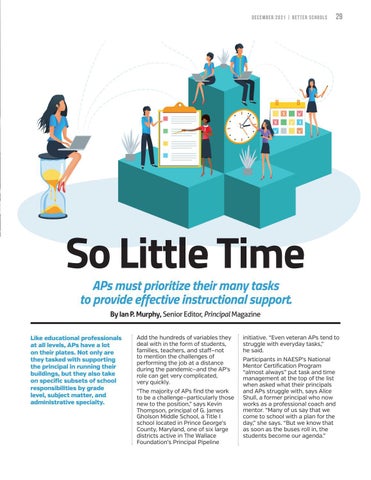Dec em ber 2021 | better sch o o ls
29
So Little Time APs must prioritize their many tasks to provide effective instructional support. By Ian P. Murphy, Senior Editor, Principal Magazine Like educational professionals at all levels, APs have a lot on their plates. Not only are they tasked with supporting the principal in running their buildings, but they also take on specific subsets of school responsibilities by grade level, subject matter, and administrative specialty.
Add the hundreds of variables they deal with in the form of students, families, teachers, and staff—not to mention the challenges of performing the job at a distance during the pandemic—and the AP’s role can get very complicated, very quickly. “The majority of APs find the work to be a challenge—particularly those new to the position,” says Kevin Thompson, principal of G. James Gholson Middle School, a Title I school located in Prince George’s County, Maryland, one of six large districts active in The Wallace Foundation’s Principal Pipeline
initiative. “Even veteran APs tend to struggle with everyday tasks,” he said. Participants in NAESP’s National Mentor Certification Program “almost always” put task and time management at the top of the list when asked what their principals and APs struggle with, says Alice Shull, a former principal who now works as a professional coach and mentor. “Many of us say that we come to school with a plan for the day,” she says. “But we know that as soon as the buses roll in, the students become our agenda.”













